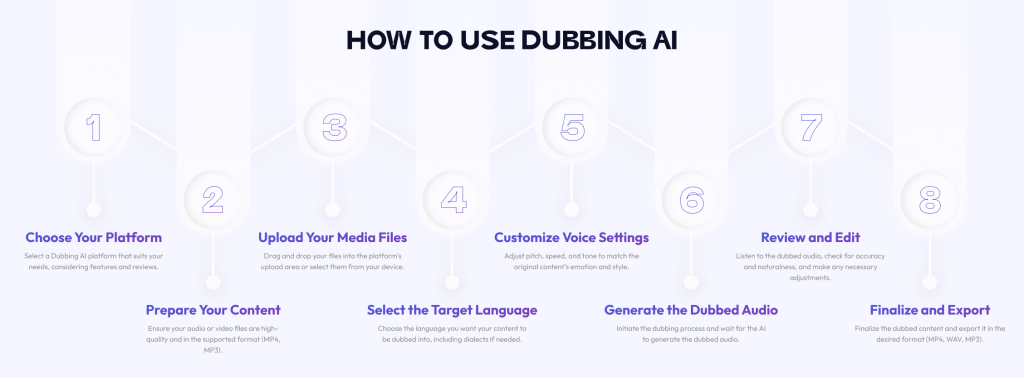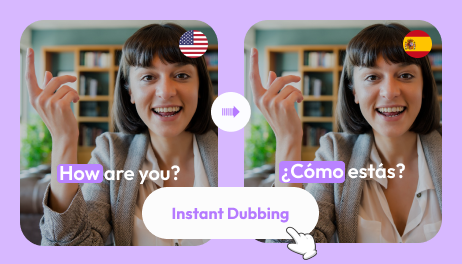Want to take your content to the next level? Dubbing AI can be your secret sauce for creating engaging, high-quality dubbed content that will captivate your audience and boost your reach.
Dubbing AI is a cutting-edge technology that revolutionizes how we experience content by breaking down language barriers and making it accessible to a global audience.
So, let’s learn the basics of AI Dubbing and how to use it to effortlessly reach a global audience. Let’s dive in!
What is Dubbing AI?
Dubbing AI is a perfect mix of technology and art that has become the center of attraction as it changes the trends of making and watching media. In its simplest form, AI dubbing implies the use of artificial intelligence to transcribe spoken text in another language. Consider it a genius speech-to-speech translator that, in addition to translating the text, transcribes it in a new voice that resembles the voice of the original speaker.
How AI Dubbing Works
- In dubbing, AI involves applying complex algorithms and natural language processing (NLP) to analyze content in audio or video format.
- It then creates a new audio track with this text in the target language, ensuring that the length and emotional tone synchronize with the original.
- It uses speech synthesis and deep learning, which have been fed large databases to produce realistic human voices.
How It Differs from Traditional Dubbing
The original dubbing technique involves replacing the original voices with human voices in the target language, which can be tiresome and expensive.
On the other hand, AI dubbing leverages text-to-speech to enable the creation of voiceovers in a few clicks without any recording requirements. This approach shortens the duration and costs while still delivering quality dubs as and when required.
How to Use Dubbing AI: Get Started
Using Dubbing AI is a straightforward process that can significantly enhance the efficiency of your content localization efforts. Here’s a step-by-step guide to help you navigate the process smoothly:

1. Choose Your Dubbing AI Platform
The first step is to select a suitable AI dubbing platform. Several options are available, each with different features. Choose a platform that offers a variety of languages, high-quality voice options, and easy-to-use interfaces.
One such popular AI dubbing platform is Wavel AI, which offers over 260 voiceovers for you to use to dub any content you want. Among all such tools, it is a fairly priced option for anyone seeking an easy-to-use tool.
You can also do your research and choose a tool you like.
2. Prepare Your Content
Once you choose a tool, you can upload your file for dubbing. But before uploading, ensure that your audio or video files are high-quality and clear. The better the quality of your source material, the better the final dubbed output will be.
Check the platform’s supported file formats and make sure your files are in a compatible format, such as MP4 or MP3.
3. Upload Your Media Files
Once your content is ready, upload it to the chosen AI platform. This is usually a simple process—just drag and drop your files into the platform’s upload area or select them from your device.
4. Select the Target Language
Choose the language into which you want to dub your content. Many platforms offer a wide range of languages and accents. Depending on your needs, you might also have the option to select specific dialects or regional variations.
5. Customize Voice Settings
Adjust the voice settings to better match the tone and emotion of the original content. You can modify aspects like pitch, speed, and intonation to make sure the AI-generated voice sounds natural and fits the context of your content. Some platforms offer advanced customization options to tailor the voice further.
6. Generate the Dubbed Audio
Initiate the dubbing process. AI will process the input to generate the dubbed audio based on your input and settings. This step’s duration can vary depending on the length and complexity of your content.
7. Review and Edit
Once the dubbed audio is ready, review it carefully. Listen to ensure that the translation is accurate and the voice matches the tone and emotion of the original voice. Many platforms allow you to make adjustments or re-generate parts of the audio if needed.
8. Finalize and Export
After you’re satisfied with the dubbed content, finalize the process and export the file in your desired format. Most platforms support common formats like MP4, WAV, or MP3, making it easy to integrate the dubbed content into your projects.
By following these steps, you can efficiently use AI dubbing to create high-quality, localized content that engages and resonates with your global audience.
Best Practices for Using Dubbing AI
To get the most out of your AI experience, it’s essential to follow a few best practices. These tips will help you achieve the best results and ensure your dubbed content sounds as natural and engaging as possible.
1. Use High-Quality Source Material
Start with clear, high-quality audio or video files. The better your original content, the more accurately the AI can replicate the voice and tone. Avoid using recordings with background noise or poor audio quality.
2. Choose the Right Platform
Select a Dubbing platform that fits your needs. Look for features like language options, voice customization, and ease of use. A good platform will make the dubbing process smoother and more effective.
3. Customize Voice Settings Thoughtfully
Take the time to adjust voice settings to match the emotion and style of your original content. Tweak aspects like pitch, speed, and tone to ensure the dubbed voice feels authentic and complements your content.
4. Review Carefully
After generating the dubbed content, listen carefully to ensure accuracy and naturalness. Pay attention to pronunciation, timing, and emotional tone. If something seems off, most platforms allow you to make adjustments or re-generate parts of the audio.
5. Be Mindful of Cultural Nuances
When dubbing content into different languages, consider cultural differences and regional dialects. Ensure the dubbed content is appropriate and resonates with the target audience.
6. Include a Human Touch
In spite of all the efforts made by AI, great results are sometimes possible only with a final check by a specialist. Often, it is helpful to have someone with knowledge about the content scan the text and verify that nothing seems off or everything sounds appealing.
Adopting these guides will help you achieve the best outcome from automated Dubbing and create meaningful content that resonates with your audience across regions.
Advantages of employing Artificial Intelligence in the making of dubbed version.
Benefits of Using AI for Dubbing
AI is revolutionizing dubbing with some impressive benefits. Here’s a straightforward look at how using AI for dubbing can make your life easier:
- Speed and Efficiency
AI can produce dubbed content much faster than traditional methods. Instead of waiting for voice actors to record and edit, AI does it quickly, helping you get your content out to your audience faster.
- Cost Effectiveness
Hiring voice actors for every language can get pricey. AI cuts these costs by automating the dubbing process. This means you get professional-quality voiceovers without breaking the bank.
- Consistent Quality
AI ensures that the dubbed audio maintains a consistent quality throughout. Unlike human actors, who might have variations in their performance, AI keeps the tone and style steady, providing a uniform experience.
- Multi-Language Support
Most AI dubbing tools support many languages and accents. This makes it easy to reach a global audience without needing a separate team of voice actors for each language. AI can handle multiple languages efficiently in one go.
- Customizable Voices
You can adjust the AI voice to fit the mood and style of your original content. This customization ensures that the dubbed audio feels natural and aligns with the original tone.
- Scalable Solutions
AI can handle large volumes of content effortlessly. Whether you’re dubbing a single video or an entire series, AI scales with your needs, making it easy to expand your content globally.
In short, AI for dubbing saves time and money while ensuring high-quality, consistent results. It’s a smart choice for making your content accessible to a wider audience.
Applications of Dubbing AI
Dubbing AI is changing the way we share and enjoy content across different languages. It has various use cases as AI is everywhere nowadays. Let’s see how AI dubbing is being applied across diverse industries:
1. Movies and TV Shows
AI dubbing is revolutionizing how films and shows are distributed internationally. For example, the popular anime Naruto uses AI dubbing to provide voiceovers in multiple languages. This allows fans worldwide to watch the series in their own language, without waiting for traditional dubbing processes.
2. YouTube and Online Content
Content creators, especially on platforms like YouTube, are using AI dubbing to expand their reach. A good example is tech reviewer MKBHD, who utilizes AI dubbing to translate his tech reviews into different languages. This approach helps him connect with a more diverse audience by sharing his ideas with people who might not speak English.
3. Educational and Training Materials
Apart from that, online learning platforms like Udemy use AI dubbing to make education more inclusive. By dubbing courses in multiple languages—like English, Spanish, and Mandarin—students from different parts of the world can access the same learning material. This is how AI dubbing improves accessibility and the reach of quality education.
4. Marketing and Advertising
Likewise, businesses apply AI dubbing to make their marketing campaigns more relevant across regions. For example, Coca-Cola uses AI to adapt its commercials into different languages. This ultimately helps it communicate its brand message to local audiences, which increases engagement and trust.
5. Corporate Training
This technology is also being used to streamline global corporate training. Companies like Microsoft use this technology to translate training videos into the native languages of employees in various countries. This strategy ensures that everyone receives the same learning experience, regardless of location.
6. Video Games
Moreover, localizing games with AI in the gaming industry improves the overall experience. Let’s take FIFA as an example, where AI dubbing is used to provide voiceovers in multiple languages. This technology allows players from different regions to enjoy the game with full immersion in their preferred language.
Hence, these applications show how AI powered dubbing is helping to bridge language gaps, making content more accessible and relevant to people worldwide.
Make Your Content Universal with Dubbing AI
Dubbing AI is changing the game for content creators everywhere. It makes it easy to share movies, videos, and educational materials with audiences around the world in their own languages. This technology isn’t just about translating words—it’s about making content feel personal and engaging for everyone.
If you’re ready to take your content global, check out Wavel AI. Its smart dubbing tools can help you reach audiences in their native languages quickly and easily. So, why are you waiting? Try Wavel Studio and watch your reach grow!
FAQ
1. Is dubbing ai easy to use?
Yes, Dubbing AI is quite user-friendly. Most platforms have simple tools and clear interfaces, making it easy to upload your content, pick the languages you want, and generate voiceovers with just a few clicks.
2. How does dubbing ai work?
Dubbing AI first listens to the original audio and then uses text-to-speech technology to create new voiceovers in your chosen language. It makes sure the new audio matches the timing and feeling of the original.
3. How do I ensure the quality of dubbing ai results?
To get the best results, choose a trusted Dubbing AI platform, use high-quality source audio, and review the final output. Many platforms also let you tweak settings to improve accuracy.
4. Can dubbing ai handle different accents and dialects?
Yes, many Dubbing AI systems can manage various accents and dialects, depending on their training. However, the accuracy might vary, so it’s good to pick a platform that supports the specific accents you need.

.webp)






